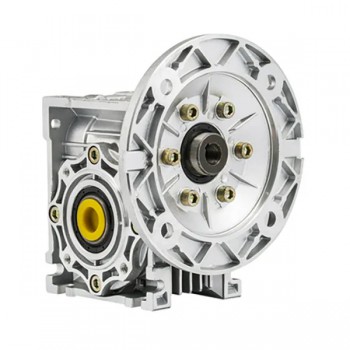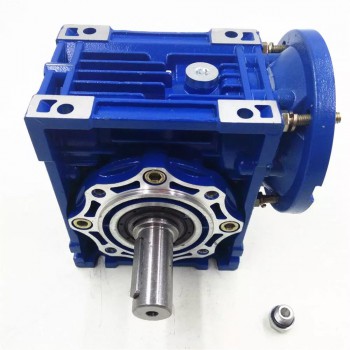Working principle and design requirements of worm gear reducer gearbox
2025/03/27 17:16
瀏覽31
迴響0
推薦0
引用0
1.Definition and characteristics of worm gear reducer gearbox
Worm gear reducer gearbox is a transmission machine with compact structure, large transmission ratio and self-locking function under certain conditions. It is one of the most commonly used reducers. Worm gear reducer gearbox is mainly used to reduce speed and increase torque. It is widely used in modern machinery, especially to match speed and transmit torque between prime mover and working machine or actuator.
2.Construction of worm gear reducer gearbox
1.Transmission parts: Worm gear is the core transmission component of reducer, and its main function is to transmit motion and power between two staggered shafts. Worm is usually made of hard material to improve wear resistance; while worm wheel is made of softer material to reduce friction and improve transmission efficiency.
2.Shaft and bearing: The parts on the shaft are fixed axially by shaft shoulder, shaft sleeve and bearing cover. Both shafts use deep groove ball bearings to bear radial load and small axial load. When the axial load is large, a combination of angular contact ball bearings, tapered roller bearings or deep groove ball bearings and thrust bearings will be used.
3. Housing: The housing is the base of all accessories in the worm gear reducer gearbox. It supports and fixes the shaft system components, ensures the correct relative position of the transmission accessories, and supports the load acting on the reducer. The housing is usually made of gray cast iron. For reducers with heavy loads or impact loads, cast steel housing can also be used.
4. Accessories: The worm gear reducer gearbox also includes some important accessories, such as oil cap/breather, end cover, oil seal, drain plug, oil mark cap/oil mark, etc. These accessories play an important role in lubrication, sealing, oil discharge, and oil quantity observation in the operation of the reducer.
3. Working principle of worm gear reducer gearbox
1. Principle of spiral transmission: The shape of the worm is similar to that of the screw, and its spiral surface is tightly meshed with the gear surface of the worm wheel. When the worm shaft rotates, the helical teeth on its spiral surface drive the teeth of the worm wheel to mesh and move, so that the worm wheel rotates along the axis perpendicular to the worm.
2. Friction transmission and self-locking property: There is a large sliding friction force on the contact surface between the worm and the worm wheel. This friction force not only transmits power, but also gives the worm gear reducer a unique self-locking property. When the lead angle of the worm is smaller than the friction angle of the contact surface between the worm wheel and the worm, the worm wheel will not be able to reverse drive the worm, that is, only the worm is allowed to drive the worm wheel to rotate.
3. Speed ratio principle: The reduction ratio of the worm gear reducer gearbox is determined by the number of worm heads and the number of teeth of the worm wheel. Specifically, the reduction ratio is equal to the ratio of the number of worm heads to the number of teeth of the worm wheel. When the number of worm heads is small and the number of teeth of the worm wheel is large, a larger reduction ratio can be obtained.
4. Energy conversion and efficiency: During the sliding contact process between the worm and the worm wheel, part of the energy will be converted into heat energy, resulting in the efficiency of the reducer being slightly lower than that of the gear reducer with pure rolling meshing. In order to improve efficiency, modern worm gear reducer gearbox usually uses high-quality lubricants to reduce friction.

4. Design requirements of worm gear reducer gearbox
1. Modulus selection: The modulus is a basic parameter in the design of worm gears, which determines the size and load-bearing capacity of the gear. A larger modulus should be selected to increase the strength and rigidity of the gear when transmitting high power or requiring high load-bearing capacity; conversely, a smaller modulus is preferred when space is limited or lightweight design is required.
2. Helix angle design: The helix angle is a key factor affecting the transmission efficiency and self-locking performance of worm gears. A smaller helix angle (usually designed in the range of 3°-10°) is conducive to improving transmission efficiency, but may sacrifice a certain degree of self-locking ability.
3. Lubrication method: Good lubrication is the key to the long-term and stable operation of worm gear transmission. Common lubrication methods include oil lubrication and grease lubrication. Oil lubrication is suitable for high-speed, heavy-load or continuous working occasions, while grease lubrication is suitable for low-speed, light-load or intermittent working occasions.
4. Accuracy level selection: The accuracy level of the worm gear directly affects the smoothness, noise level and service life of the transmission. High accuracy level can provide better transmission performance and lower noise level, but the manufacturing cost also increases accordingly; low accuracy level is low cost, but it may sacrifice transmission efficiency and life.
5. Material selection: Usually includes steel and non-ferrous metals, and their processing methods vary depending on speed and load.
6. Thermal balance calculation: One of the key factors to ensure the stable operation of the system, aimed at preventing lubrication failure and system performance deterioration.
7. Geometric dimension calculation: Including calculations such as pitch circle diameter, tooth top circle diameter and tooth root circle diameter, to ensure the accurate installation of the worm and worm wheel and the efficient and smooth operation of the transmission system.
自訂分類:不分類
上一則: Design points and maintenance measures for stepper motor encoders下一則: How to extend the service life of helical planetary gearboxes
你可能會有興趣的文章:
- What are the installation precautions for helical planetary gearboxes?
- How to extend the service life of helical planetary gearboxes
- Debugging steps and optimization methods of closed-loop stepper motors
- Driving mode of pancake stepper motor
- Methods for judging and maintaining stepper motor encoder faults
- CHARACTERISTICS OF VARIABLE RELUCTANCE STEPPER MOTOR
限會員,要發表迴響,請先登入



